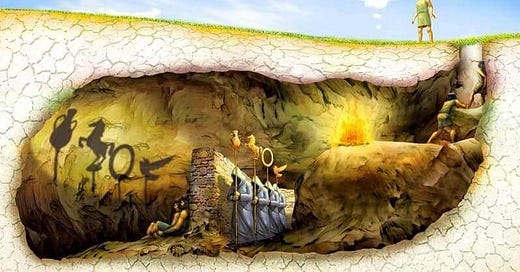“Reality is merely an illusion, albeit a very persistent one.”
— Albert Einstein (or a Zen master?)
What do Plato’s cave and the Buddhist concept of illusion (māyā) have in common? One arises in ancient Greece, the other in the Indian subcontinent. One speaks of shadows on the wall, the other of dreams, smoke, and reflections. Yet, at the heart of both is a question that never gets old:
Are we really seeing the world as it is? Or just a projection, a trick of the light?
Let’s enter the cave. And then… let’s sit down and meditate in it.
Plato’s Cave: Chained to Appearances
In Plato’s Republic, the Allegory of the Cave shows prisoners chained since birth in a dark cavern. All they can see are shadows on the wall—projections of real objects behind them, which they cannot turn to see. These shadows are all they know. For them, the shadows are reality.
One prisoner escapes and is blinded at first by the light outside. But soon, he sees the truth: the sunlit world beyond the cave. He returns to help the others—but they laugh, resist, or even kill him. The truth is too painful.
Plato uses this to suggest that most humans live in illusion, mistaking sensible appearances for true reality. Real knowledge (episteme) comes only from turning the soul away from the senses and toward the eternal Forms—especially the Form of the Good, symbolized by the sun.
Buddhist Māyā: A World Like a Dream
In early Buddhist texts, we find a different but resonant teaching. What we perceive—the body, thoughts, people, even the “I”—are not what they seem. These are not eternal truths, but impermanent, unsatisfactory, and without a fixed self (anicca, dukkha, anattā). And yet, we cling to them.
This clinging, based on ignorance (avijjā) and mental distortion (vipallāsa), creates an illusory sense of reality.
Later Mahāyāna sutras go further: the world is like a mirage, a magician’s trick, a bubble, a reflection of the moon in water. It appears, but is empty (śūnyatā) of any intrinsic substance.
"All conditioned things are like a dream, an illusion, a bubble, a shadow…”
— Diamond Sutra
Unlike Plato’s eternal Forms, Buddhism says: there is no ultimate “thing” behind the illusion. Not even the “self.” The illusion is not just about seeing wrongly—but about believing in solidity where there is only process.
Keep reading with a 7-day free trial
Subscribe to The Gentle Law to keep reading this post and get 7 days of free access to the full post archives.





